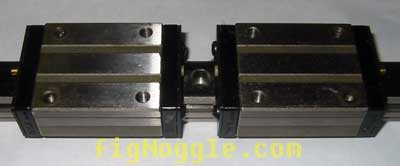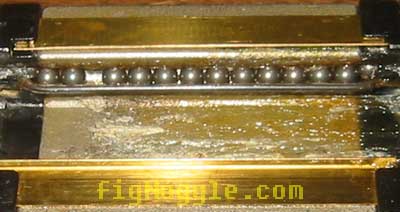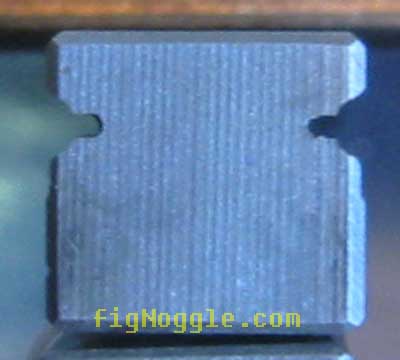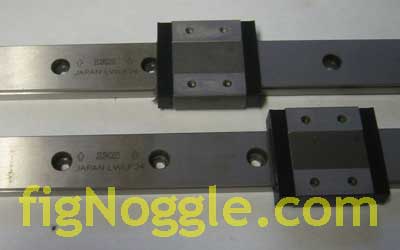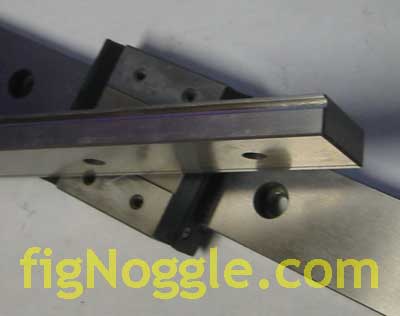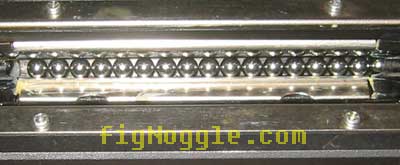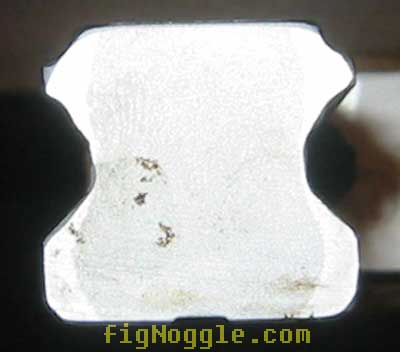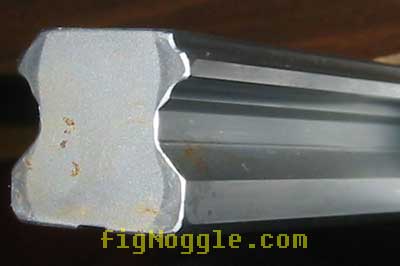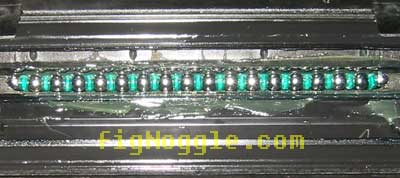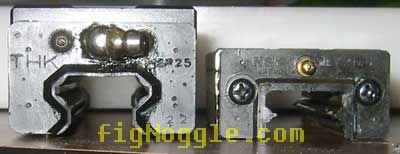
Copyright 2011. figNoggle Designs.
7x10, 7x12, 7x14 Mini-Lathe Information
Website Links
Post a link to your website or view other hobby and machine and metalworking websites for free.
|
Rent Mill & Lathe DVDs at Smartflix | Great aluminum & steel prices at OnlineMetals
LINEAR BEARINGS AND GUIDES - A Comparison Between "Standard" Styles and 4-Way Equal Load StylesAs you saw in the previous article where the THK SHS-series pricing chart was made available, here we'll not only take a look at these but also the more wide-spread HSR-series and a "standard" style from NSK. Pictured below is a NSK 20mm standard linear bearing and guide assembly. You will find these styles and sizes popular in used markets.
What makes these standard are its use of a single row (on both sides of the rail) of bearings that make contact with the rail. Here is the underside of the bearing:
What makes this a better version of the standard style is that there is a bearing retainer that prevents the balls from falling out all over the place when removed from the guide. If you've ever played around with ballnuts, you'll know how much care you have to employ to make sure the ball bearings don't fall out of the ballnut when removed from the ballscrew. Here is a picture of the profile of the rail. Notice the indentations on either side of the rail. This is where the ball bearings make contact - at 90 degrees or perpendicular to the rail. The additional relief is for the ball bearings retainer "ring":
Now we'll move on to something a bit fancier, this time from THK. As mentioned before, the HSR series is a 4-way "equal load" bearing bearing. This makes for a very rigid assembly in radial and axial directions when those forces are applied. What you may be confused about is the term "caged bearing". This does not mean that the ball bearings are retained in any fashion such as that employed by NSK in the above example. Below is the underside of the HSR series bearing. Notice that there are two rows on either side (one side is not shown) which makes contact above and below at 45 degrees to the rail. While there's no visible retainer "spring", they are in fact retained by the races so that the balls don't fall out. Here's an example of the non-retained type slide/bearing. Below is a IKO LWLF24 (wide, low profile) bearing and slide.
If you look at the bearing race along the side of the rail, you'll notice that there is no indentation for the ball bearing retainer. Thus, be cautious when removing them from the rail as they are not held in place and when disengaged from the rail the ball bearings will indeed fall out and land all over your floor!
Now we'll look at the 45 degree contact angle (4-way load) type of bearing and rail. Here's the THK HSR series bearing:
What makes THK system nice (others do this too) is that the HSR and SHS series bearings are interchangable on the rails. Here's what the "4-way equal load" rails look like. The first is a profile shot:
This shot makes it clearer how the bearings make contact with the rail:
Going back to the difference between the HSR and SHS... Here's a picture of the underside of a SHS-series bearing. Notice the green plastic spacers in between each bearing? These are the cages that make for smoother and quieter movement since the ball bearings can't click and clack next to each other. Looks like a set of dental braces, doesn't it?
Finally, here is a picture of the 45 versus 90 degree type bearings:
On the left is the 45 and on the right is the 90. The main point we wanted to make was that when possible, the 4-way style is probably a more desirable setup. While the 90 degree style (like THK's SRS, RSR, SR, etc..) bearings are fine for mostly horizontal loads (like in the case of a X-Y table), you may want to use the 45-degree style for the Z-axis. You may also get around this if you use a triangulated rail system on the Z-axis with standard rails. We hope this helps shed some light into this sometimes mystical world of linear bearings. Happy building! View the THK SHS-Series pricing chart prepared by figNoggle Designs. |
Looking for mini-mill help and how-tos? How about lathe help and how-tos?
We're prototyping a benchtop CNC vertical mill using the DigiSpeed-XL interface card for Mach, Dart Controls and KB Electronics KBIC/KBMM 90VDC motor controllers, 1.5HP treadmill motor from Surplus Center and a R8-spindle head from the X2 mini-mill - not to mention Gecko servo drives and an entirely closed-loop system. Come take a look!CNC 8x12 Lathe
Check out our newest developments like the CNC/DRO 8x12/8x14 lathe using Gecko drives, break-out board, NEMA 34 step motors, DRO and more!
SUPERX3.COM
Sieg X3 and Super X3 Grizzly G0463 Info
MDAHacks.com
T-Mobile MDA / Cingular 8125 / HTC Wizard Hacks, Tweaks, Tips, Tricks and More!
Metal Working FAQ.NET
Your source for metalworking and machining, tips, tricks, and more. Over 50 content wiki sites!
